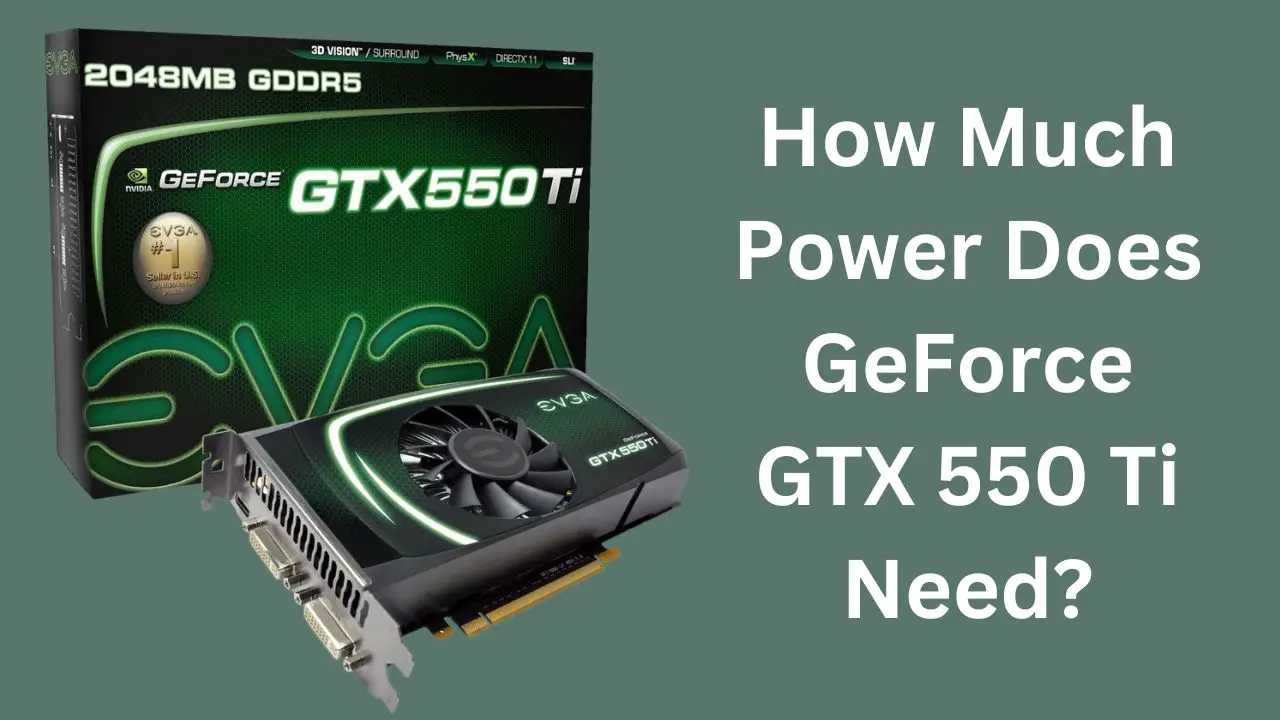Based on the NVIDIA GeForce GTX 550 Ti specifications, it requires a 1x 6-pin power connector and has a maximum power draw of 116 W.
To accommodate this, a power supply unit (PSU) must offer at least that amount of power for the card, in addition to the power needed for other system components.
A practical guideline involves selecting a PSU with a minimum of 20% additional wattage above the total system power usage.
For example, if your system uses 300 W without the graphics card, you need a PSU with at least (300 + 116) x 1.2 = 500 W to run the GeForce GTX 550 Ti.
How Much Power Does GeForce GTX 550 Ti Use?
The power draw is rated at 116 W maximum. This is the amount of power that the card uses under full loads, such as when gaming or running intensive applications.
Power consumption can differ based on the particular model and producer of the card, as well as the load and settings utilized.
Some custom cards may have higher clock speeds or additional features that increase power draw.
For example, the ASUS GeForce GTX 550 Ti Direct CU has a slightly higher power consumption than the reference design, reaching up to 128 W under full load.
How does underclocking affect the power consumption of the GeForce GTX 550 Ti?
The NVIDIA GeForce GTX 550 Ti has a base clock speed of 900 MHz and can draw up to 116 W of power.
Lowering the clock speed by a percentage should also reduce power consumption by a similar percentage, provided that voltage remains constant.
For instance, a 10% reduction in clock speed results in approximately 10% lower power consumption, causing a power draw of about 104 W.
Lowering the voltage of the component in addition to underclocking can additionally diminish power consumption and heat output.
Power consumption has a quadratic association with voltage, indicating that a minor voltage reduction can yield a substantial power consumption decrease.
As an example, a 10% voltage reduction can result in approximately 19% lower power consumption, assuming that the clock speed remains unaltered.
Consequently, underclocking combined with undervolting can have a notable impact on the power consumption of the GeForce GTX 550 Ti.
Are there any power-saving features built into the GeForce GTX 550 Ti?
Yes, the GeForce GTX 550 Ti incorporates power-saving capabilities. NVIDIA Power Management dynamically modifies the GPU’s clock speed and voltage based on load and settings.
Consequently, the GPU consumes less power and emits less heat during idle or low-intensity tasks by decreasing performance.
In contrast, the GPU consumes more power and generates more heat during high load or demanding applications by increasing performance.
These adjustments optimize GPU performance and power efficiency across various scenarios.
NVIDIA Adaptive Vertical Sync, another power-saving feature, aligns the GPU’s frame rate with the monitor’s refresh rate. This alignment successfully eradicates screen tearing and stuttering.
How much heat does the GeForce GTX 550 Ti generate when running at full power?
ASUS GeForce GTX 550 Ti Direct CU has a load temperature of 72°C, which is lower than the reference design’s load temperature of 79°C.
The ASUS card also has a higher power consumption of 128 W under full load.
How does overclocking affect the power consumption of the GeForce GTX 550 Ti?
Overclocking the GeForce GTX 550 Ti speed affects power use directly. When pushed past factory settings, power needs to grow.
A 6% speed boost raised power use by 26 watts or 11%. More power consumed creates extra heat, impacting card temperature.
In a FurMark 1.9.1 stress test, the peak temperature was 85℃. Nonetheless, speed enhancement may not lead to significant performance gains.
Assessing the balance between increased power use, heat, and potential performance improvements is crucial, as it may not justify the trade-off in most situations.







